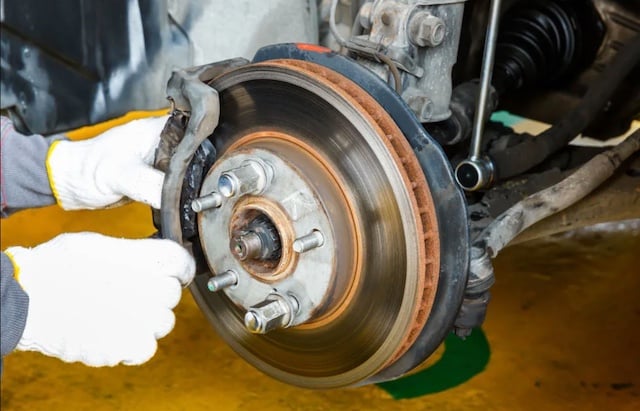
Inspecting your brake pads and rotors is an important part of regular maintenance. Brakes are a wear item and several factors can determine how long they will last, including:
- Driving style
- Driving routine
- Annual mileage
- Climate conditions
- Geographic location
Test Drive

How your brakes feel and sound while driving can indicate possible excessive brake wear. Here are some things to check for while driving:
Warning Indicator
If the red brake light is illuminated, the fluid may be low if the pads are worn thin. If an amber brake light is illuminated, an electronic sensor detects worn brake pads.
See your owner’s manual for more information.
Squeaking Or Grinding Noises
A metal wear indicator in contact with the brake rotor may cause a squealing noise when the brake pads are worn. A grinding noise may indicate metal-to-metal contact between a brake pad and rotor.
Brake Pedal And/Or Steering Wheel Vibration
A vibration in the brake pedal or steering wheel may indicate warped brake rotors or unevenly worn brake pads.
Pulling To One Side
The vehicle might pull in one direction while braking. This may indicate the brake pads are stuck or binding in the caliper. It’s also possible a caliper piston may be seized.
Visual Inspection

Some visual inspections will reveal the condition of your brake pads and rotors. Follow the steps below to determine the condition of your brakes:
Check The Brake Fluid Level
Open the hood and locate the brake fluid reservoir at the back of the engine on the driver’s side. Check if the brake fluid is at the “full” line. If the brake fluid is low, the brake caliper pistons may be extended from brake pad wear.
Inspect The Brake Pads Through The Wheels
You may be able to inspect the brake pads through the wheels. The brake pad material shouldn’t be less than a quarter inch.
Remove The Wheels To Inspect The Brakes
You may need to remove the wheels to see the brake pads. It is better to remove the wheels for a more thorough inspection.
- Raise and support the vehicle.
- Remove the wheel.
- Look through the caliper and inspect the inboard and outboard pads.
- If the pad material is unevenly worn or less than a quarter inch, the brake pads should be replaced.
- Inspect the brake rotors for grooves, pitting, or high spots. If the rotor is not smooth, it should be replaced.
- Always replace or resurface the brake rotors when replacing the pads.
- Repeat the brake inspection at the remaining wheels.
- Always replace both brake pads (and both rotors) per axle. Never replace only one side.
Looking for tips on how to service your disc brakes? Check out our blog post.
Buying The Right Brake Pads And Rotors For Your Vehicle

- BuyBrakes has the best selection of brake pads and rotors at the best prices.
- We have (8) warehouse locations across the US for the best availability of parts and the fastest shipping times!
- We offer free shipping on all orders over $99.
Do you have more questions? We’re here to help. Feel free to contact us.



